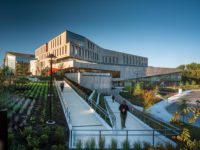Porchdog (Tyler Residence)






























Architects & Firms
Biloxi, Mississippi
Ask Biloxi, Mississippi resident Richard Tyler what he thinks of his house, designed by architect Marlon Blackwell, AIA, and he seems a little shocked at the question. “I love my house,” he says without a moment’s hesitation, “it’s home, you know what I’m saying?”
But the question is a fair one, given that the 1,492-square-foot house is not exactly typical of the area, and given that the homeowner is not your average client. Tyler, who has lived his entire life in Biloxi, saw the house he grew up in and inherited destroyed during Hurricane Katrina five years ago this month. Living in a FEMA trailer with his family since then, the residential and commercial painter and single father of three was chosen by Habitat for Humanity’s Biloxi Model Homes program to choose an architect from a group of 15 to pair up with—an architect who had designed a house that would comply with all the new environmental, structural, and FEMA regulations.
The most basic requirement was that the house be able to withstand a Category 4 storm surge. “But it had to do more than that,” says Blackwell, “It also had to maintain the social and urban mentality of the region. The house had to incorporate the area’s porch culture and still be elevated 11 feet off the ground.” Blackwell, who has been quoted as saying that the house he designed for Tyler is “a tough structure responding to a Darwinian moment,” chose to challenge the traditional notion of the Gulf Coast streetscape with this house. He says he’s not a fan of some of the New Urbanist ideas for the region, which, he insists, “want to just put Grandma’s house up on stilts. Such ideas are not offering real solutions to the problem. Where they see houses stylistically [shotgun, ranch, colonial, etc.], as a fixed notion, we see them as an evolution.”
With Porchdog, the last residence to be built in the Biloxi Model Homes program, Blackwell took inspiration from the traditional shotgun house, but turned the type on its head. Or, more literally, cut it in half and stacked it. “We tried to demonstrate an adaptability,” says the architect. “Yes it’s in contrast to its neighbors, but it draws its sources from the region—the region is in its DNA.” Essentially open at the ground level, the house incorporates a street-level porch. Porchdog is a hybrid of steel and wood framing—all steel on the lower level, with mostly wood framing above the flood elevation (there is also a large steel “X” cross-brace on the east elevation for more support). All construction below the 11-foot flood elevation is fabricated from rot- and moisture-resistant materials, such as an entry stair and rear deck stair of perforated steel and rot-resistant wood, an enclosed storage volume of concrete masonry units, a parking area, and a concrete stoop. The rot-resistant wood or metal skin covers the entire building and wraps the roof.
Three bedrooms, a living room, study, and two bathrooms are contained in the two-level space above the flood level, while a deck at the rear is shaded by operable metal shutters. “The shutters are like a veil,” says Blackwell. “You can close this house up and leave during a storm, and it will still be there when you come back.”
All of the money and materials were donated or sponsored, and Blackwell himself raised some of it. “We insisted on making the ground floor usable,” he says, “and that cost more than we had.” He also raised money for furnishings. The original bid called for $85 per square foot—Blackwell’s final cost was $132 per square foot. “This house is a prototype, and we wanted to do it right. I do think we could do it for less if we did it again.”
The house was completed in November of 2009, and there never was a more grateful occupant than Tyler, who had been living in the FEMA trailer for four years. “I love my house, I’m proud of it,” he says, acknowledging that he’s become a bit of a celebrity in the neighborhood. “Everybody wants to see my house. It was a long time coming, so I don’t mind.” Tyler especially gives a nod to Blackwell. “He fought for this house,” he says, “and he definitely had my interests at heart.”
People
Architect:
Partner In Charge:
Project Manager:
Designers:
Engineer:
Photographer
Renderer
CAD system, project management, or other software used: |
Products
Structural system:
Doors
Watson Welding & Metal Fabrication
Overhead Doors (West)
Watson Welding & Metal Fabrication |

















